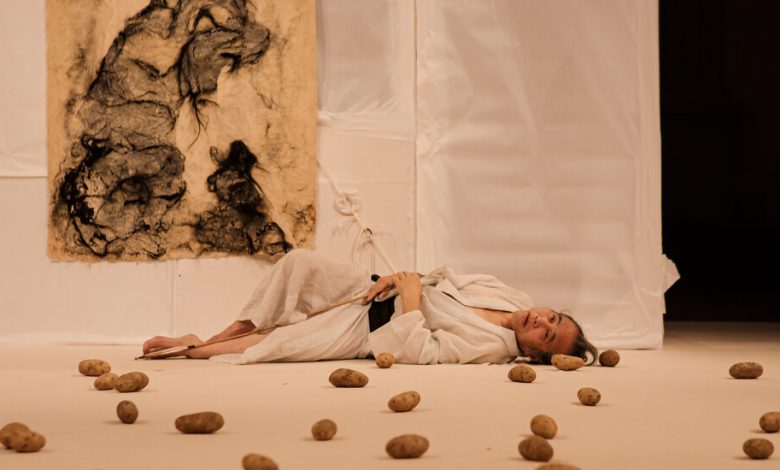Review: A Haunting Koma Otake Dances With the Collective ‘You’

Slowly, gingerly, the dancer and choreographer Koma Otake shuffles onto a gleaming white stage scattered with potatoes. Wearing brown boots without laces and draped in fabric, he makes his way across the space when a bulky mound of material slips down his back. With a restless squirm, he shakes it until potatoes rain onto the floor like hail, adding more objects to the theatrical canvas. He rips the burlap sack off his back and whips it into the air, sending it offstage with a flourish.
Like nearly every moment in Otake’s triptych, “You,” performed at Danspace Project, in Manhattan, on Thursday, this stream of movement seems like a slow-motion dream in which anguish and grief ripple across the stage like wounds incapable of closing. (By the end, Otake’s scratched up legs are actually bleeding.) All the while, he trudges along, edging his way around his performance space: dodging potatoes; ripping through his paper set of four shoji screens; and, over the course of the evening-length work, performing a striptease. By the final scene, he’s naked. Disrobing is his way to calm down, he writes in his choreographer’s notes, some of which are read in an opening voice-over.
The Japanese-born Otake, who is in his mid-70s, began working on his own in 2016 after decades creating performance works with his wife as the duo Eiko and Koma. (Then he was known simply as Koma.) Like “The Ghost Festival,” his first multidisciplinary solo, “You” — sad, strange, evocative — is part performance and part installation. A painting by Otake hangs in front of the screens; it looks to be a person holding an injured animal. But blink, stare at it again, and it becomes something else.
In the opening section, Otake picks up a potato and hurls it toward his painting, later stabbing the screen it hangs on with an arrow. Potatoes, we learn from Otake’s notes, are bombs. “They are also the dead people on the ground.”
Amy Winehouse’s “Back to Black” plays, after which he shouts unintelligible words, as if he were talking to ghosts. Is his body doing the haunting or is it haunted? His progress is marked by a spiraling spine and peculiar, carefully articulated steps, in which he lingers on outer edges of his feet, often lifting and stretching his toes apart like tentacles. The eerie expression on his handsome face veers from horror to vacant to almost amused. This isn’t a happy dance as the voice-over warned us from the start: “‘You’ is a dance of ‘I have nothing.’”
But there are touches of absurdity. As it progresses, “You” slips deeper and deeper into the psyche of a man who, perhaps, is looking back at his life. A tragicomedy sensibility takes over, which is somehow rooted in Otake’s fearlessness: He holds nothing back as he dances with a variety of objects or invisible people; to him, they represent the collective “you,” which, he writes, are “a friend, a parent, a brother, a street and a thing.”
Having slipped out of his shoes in the first section, he pulls down his kimono so that he is bare-chested in the second section while cradling then destroying a chair, starting with a punch through its paper seat and then tearing at its splintery legs. He dons a red chili pepper necklace (his notes explain that peppers protect a house from evil) and drifts across the stage to tango music while dabbing his face with a sponge covered in white paint.
Pulling back a corner of the work’s Marley dance floor, Otake is on a mission: to break down his set. At the same time, he becomes increasingly disheveled. He rips up a shoji screen by stumbling through it; he unfastens his painting, which falls to the floor. It’s like a tornado has blown through the space.
In the final section, Otake stands with his back to the audience and deliberately slides out of his kimono until he is naked. To tango music, he leans over a window ripped out of the screen and pushes over it, so that his rear and legs hang over the edge. OK, now this is funny. And diabolical. But soon, the mood shifts and just as his set has fallen apart, so does Otake. Dabbing his body with more white paint, he scoots closer and closer to his painting until he is curled up beside it. As Winehouse’s lyrics hinted earlier in the night, this is Otake’s resting place: “And I go back to black.”
Koma Otake: “You”
Through Dec. 31 at Danspace Project Manhattan; danspaceproject.org.





